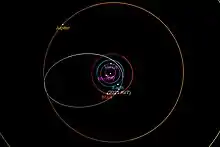2021 AV7
2021 AV7 is a near-Earth asteroid of the Apollo group, discovered by astronomers Alain Maury and G. Attard at San Pedro de Atacama, Chile on 15 January 2021. With an estimated diameter of 450–1,000 m (1,480–3,280 ft), it is considered a potentially hazardous asteroid. It has a highly elliptical orbit that brings it within Earth's orbit. Although its nominal orbit has a small minimum orbit intersection distance around 82,000 km (51,000 mi) from Earth's orbital path, the asteroid does not appear to make any close approaches within 0.2 astronomical units (30×106 km; 19×106 mi) over the next 100 years given its highly uncertain orbit.[5]
| Discovery [1][2] | |
|---|---|
| Discovered by | AMACS1 (W94) Alain Maury G. Attard |
| Discovery site | San Pedro de Atacama |
| Discovery date | 15 January 2021 (first observed) |
| Designations | |
| 2021 AV7 | |
| P11bC3C [3][4] | |
| NEO · Apollo · PHA [5] | |
| Orbital characteristics [5] | |
| Epoch 17 January 2021 (JD 2459231.5) | |
| Uncertainty parameter 7 | |
| Observation arc | 16 days |
| Aphelion | 5.203±0.007 AU |
| Perihelion | 0.8973 AU |
| 3.050±0.004 AU | |
| Eccentricity | 0.70579±0.00038 |
| 5.33±0.01 yr | |
| 302.425±0.109° | |
| 0° 11m 6.158s / day | |
| Inclination | 29.398±0.009° |
| 153.494±0.006° | |
| 7 April 2021 [5] | |
| 39.055±0.005° | |
| Earth MOID | 0.00055 AU (82,000 km) |
| TJupiter | 2.651 |
| Physical characteristics | |
Mean diameter | 0.47–1.00 km (assumed albedo 0.05–0.25)[6] |
| 20.0 (current)[7] 19.8 (at discovery)[1] | |
| 18.76±0.44[5] 18.79[2] | |
Discovery
2021 AV7 was discovered by astronomers Alain Maury and G. Attard at San Pedro de Atacama, Chile on 15 January 2021. It was first observed in the constellation Canis Major at an apparent magnitude of 19.8.[1] The asteroid was moving at an on-sky rate of 1.15 arcseconds per minute, located 0.656 AU (98.1 million km; 61.0 million mi) from Earth.[8]
The asteroid was subsequently listed on the Minor Planet Center's Near-Earth Object Confirmation Page (NEOCP) as P11bC3C.[4] Over three days, follow-up observations were carried out by various observatories including Spacewatch (691) at Kitt Peak and the Steward Observatory (I52) at Mount Lemmon. The listing was confirmed and publicly announced as 2021 AV7 on 18 January 2021.[1]
Orbit and classification

Having been observed for only 16 days, the orbit of 2021 AV7 is highly uncertain with a condition code of 7.[2] Additional observations over several oppositions are necessary to constrain its orbit over the long-term.
2021 AV7 orbits the Sun at an average distance of 3.05 AU once every 5.33 years. Its orbit has a high eccentricity of 0.71 and an inclination of 29° with respect to the ecliptic plane. Over the course of its orbit, its distance from the Sun ranges from 0.90 AU at perihelion to 5.2 AU at aphelion, crossing the orbits of Earth, Mars, and Jupiter.[5] Since its orbit crosses that of Earth's while having a semi-major axis greater than 1 AU, 2021 AV7 is classified as an Apollo asteroid. Although its nominal orbit has a small minimum orbit intersection distance around 82,000 km (51,000 mi) from Earth's orbital path, the asteroid does not appear to make any close approaches within 0.2 astronomical units (30×106 km; 19×106 mi) over the next 100 years given its highly uncertain orbit.[5]
Physical characteristics
Diameter and albedo
Based on an magnitude-to-diameter conversion and a measured absolute magnitude of 18.76, 2021 AV7 measures between 470 and 1,000 meters in diameter for an assumed geometric albedo of 0.25 and 0.05, respectively.[2][6]
References
- "MPEC 2021-B45 : 2021 AV7". Minor Planet Electronic Circular. Minor Planet Center. 18 January 2021. Retrieved 19 January 2021.
- "2021 AV7". Minor Planet Center. International Astronomical Union. Retrieved 19 January 2021.
- "2021 AV7". NEO Exchange. Las Cumbres Observatory. 18 January 2021. Retrieved 19 January 2021.
- Gray, Bill (18 January 2021). ""Pseudo-MPEC" for 11E401". Project Pluto. Retrieved 19 January 2021.
- "JPL Small-Body Database Browser: 2021 AV7" (2021-01-31 last obs.). Jet Propulsion Laboratory. Retrieved 19 January 2021.
- Bruton, Dan. "Conversion of Absolute Magnitude to Diameter for Minor Planets". Department of Physics, Engineering, and Astronomy. Stephen F. Austin State University. Retrieved 19 January 2021.
- "2021AV7". Near Earth Objects – Dynamic Site. Department of Mathematics, University of Pisa, Italy. Retrieved 19 January 2021.
- "2021AV7 Ephemerides". Near Earth Objects – Dynamic Site (Ephemerides at discovery (obs. code W94)). Department of Mathematics, University of Pisa, Italy. Retrieved 19 January 2021.
External links
- "Pseudo-MPEC" for P11bC3C, Project Pluto, 10 January 2021
- 2021 AV7 at NeoDyS-2, Near Earth Objects—Dynamic Site
- Ephemeris · Obs prediction · Orbital info · MOID · Proper elements · Obs info · Close · Physical info · NEOCC
- 2021 AV7 at ESA–space situational awareness
- 2021 AV7 at the JPL Small-Body Database